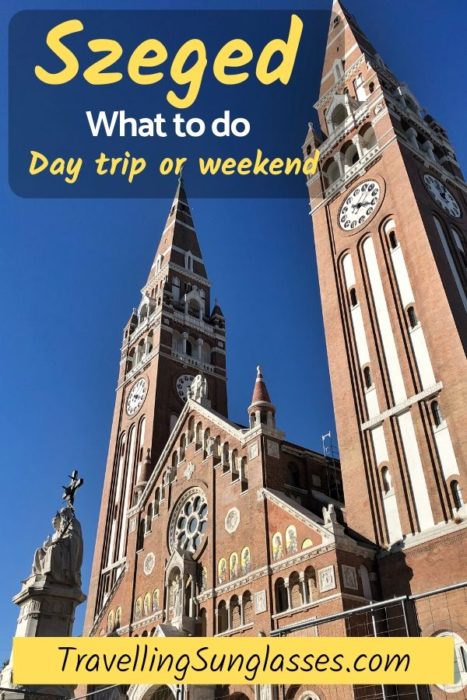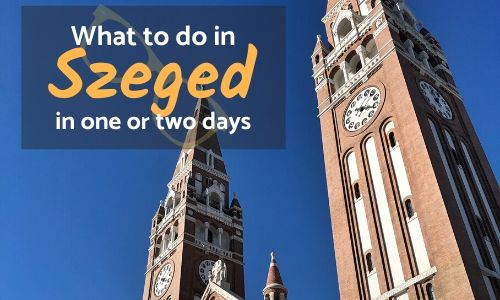Whether you are planning a one-day trip or a two-day escapade, we can help you decide what to do in Szeged, Hungary. This beautiful town located in Southern Hungary has a lot to offer, from its magnificent Votive Church to impressive Art Nouveau buildings, from outdoor activities to delicious gastronomy.
Looking for other destinations from Budapest? Check out also the day-trip or weekend to Tapolca!
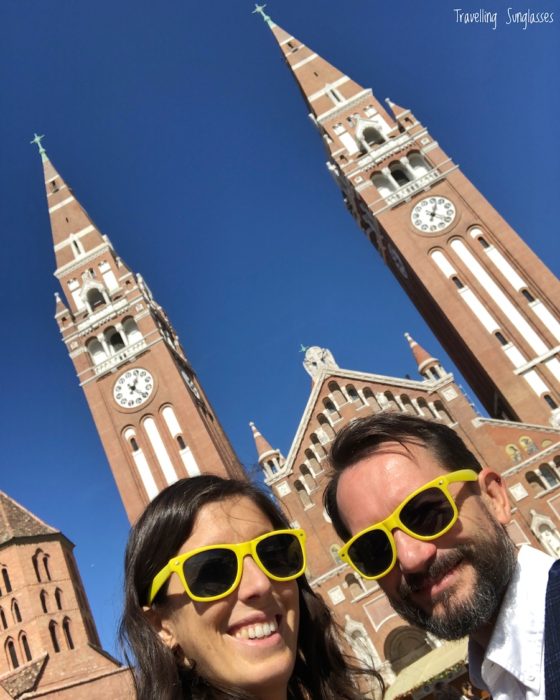
Help me run my blog! This post contains some affiliate links: the small commission I may earn if you click through and make a purchase/booking (at no extra cost to you) will go towards supporting the site and our travels. That means more posts and useful info for you!
We only recommend products we use ourselves and believe in. Thank you for supporting Travelling Sunglasses!
Click here to read our full disclosure.
A few facts about Szeged, Hungary
The weather is so good, it’s called “the city of sunshine“! Szeged has the highest number of sunny days in Hungary.
Located at the confluence of rivers Tisza and Maros, Szeged (map here) is the third-largest city of Hungary with approximately 160000 inhabitants.
Szeged is known as the home of paprika, and the world-famous Pick Salami Factory was established there in 1869.
The architecture in Szeged features large avenues and beautiful, 20th-century buildings because of the Great Flood of 1879, which wiped away the whole town. Emperor Franz Joseph personally promised to make it “more beautiful than it used to be”, and he kept his promise: the Neoclassical, Eclecticist and Art-Nouveau styles mix together in a wonderful way.
How to get from Budapest to Szeged
By train from Nyugati Station in Budapest to Szeged. It takes approximately 2 – 2,5 hours and costs 3500-4000 HUF (10-12 EUR). Find the updated timetable on the Elvira Mav Start website. Buying the ticket online requires a registration; otherwise, buying the ticket from the machines at the station is quite straightforward (and you can save on exchange rates by paying with the wonderful Wise multi-currency card! Do yourself a favour and get your Wise debit card here.)
By car on the M5 highway in approximately 2 hours. You have to buy the “vignette” highway pass at a gas station.
The best things to see in Szeged
Use our map to create your itinerary! Szeged downtown is very easy to visit on foot, as it is included between the Tisza River and the semi-circular Tisza Lajos Körút to the left.
The descriptions below (except for the New Synagogue) actually form the Szeged itinerary on foot that we followed.
Make sure you stop by the Tourinform info point on Szechenyi Square (map here) to pick up some useful leaflets and booklets: we loved the “Art Nouveau Route” of Szeged and Subotica, and the history of The Votive Church of Szeged.
Dom square
Start your Szeged sightseeing tour from the main square, Dom Tér (map here).
Built between 1928 and 1930, it is lined with elegant buildings in Northern-European style which house university institutes and the Bishop’s Palace. Thanks to its impressive size (12000 square meters, just like St. Mark’s Square in Venice!) it is the location of many festivals, religious performances, and theatre shows.
Opposite the Votive Church (Dom), take a look at the Musical Clock: at 12.15 and 17.15 every day, it shows the graduating students’ school-leaving ceremony, at the end of the academic year. At every hour it also plays the song “Szeged is a famous city”.
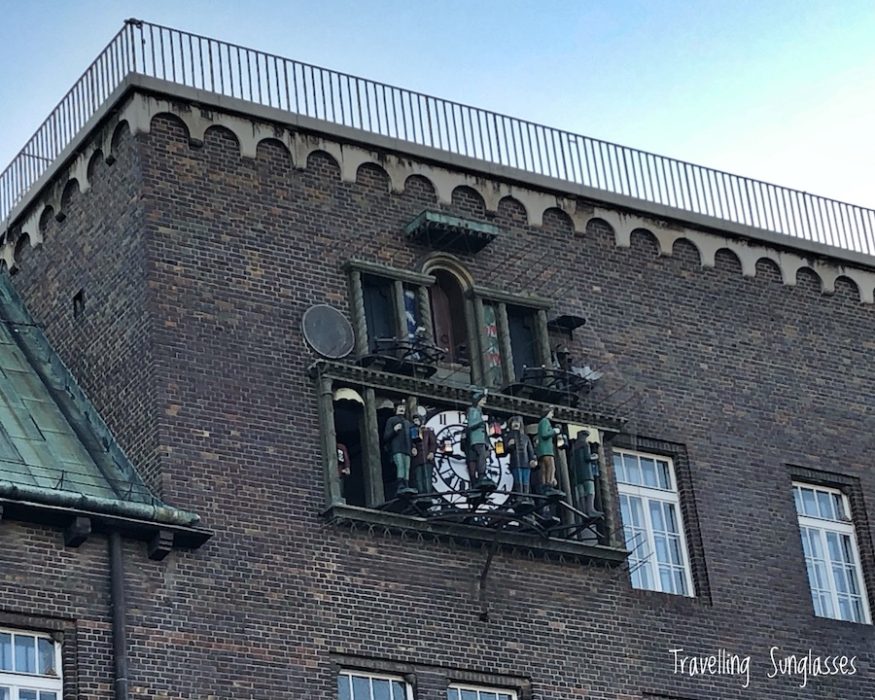
The Votive Church (Dom) and Saint Demetrius tower (Dömötör Torony)
Very simply put, the Votive Church of Szeged is impressive (Hungarian: Szegedi Dom, map here). With its two 81-meter spires towering on the spacious Dom Square, the 51-meters large façade fits gracefully in the frame.
Even though the construction began in 1913 (after the Great Flood of 1879), it was sanctified as the Cathedral of Our Lady of Hungary only in 1930, due to World War I delays. The architecture mixes Neo-Romanesque, Gothic, and Byzantine styles, creating an almost Mediterranean feeling.
I spent quite a while admiring the beautiful mosaics on the façade, perfectly encased in the red bricks and white details.

The interior of the Votive Church is even more stunning. The vault is simply enormous, and the main dome creates even more space.
The Art Nouveau decorations are so diverse that your eyes keep bouncing from side to side, yet everything fits harmoniously: flowers, leaves, geometric details, and much more.
The Byzantine style is maintained with rich ornaments and shiny golden details. Paintings and frescoes depict stories of Hungarian figures and, of course, the Great Flood destruction and rebirth.
Last but not least, the remarkable stained glass windows were made by Miksa Roth, who also made the windows of the New Synagogue of Szeged, of Saint Stephen’s Basilica and of the Parliament in Budapest.
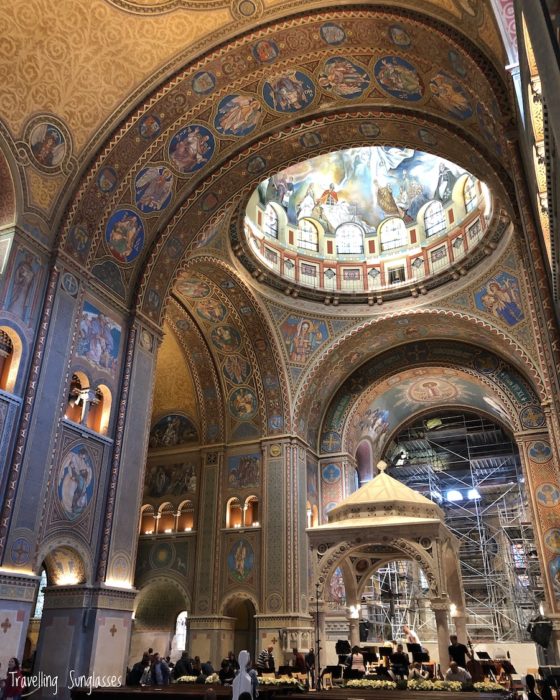
Saint Demetrius Tower stands outside the Votive Church. With 11th century foundations, this is the oldest architectural relic of the city; it survived the Great Flood and was turned to baptizing chapel of the Votive Church, when this was built. Tickets to the tower and the exhibitions on the first and second floor are available at the Visitor Centre.
Visit the Votive Church and Saint Demetrius Tower
The Votive Church is open approximately from 7 AM to 7 PM, but best to check here the updated opening hours and celebrations (Hungarian: nyitvatartás). As of September 2019, the entrance was free of charge.
The visitor centre is open from 9 AM to 5 PM, Tuesday to Sunday. The entrance is under the stairs in front of the entrance of the Church. Here it’s possible to buy tickets for the exhibitions, the towers and Dömötör Tower (all combined are 1800 HUF/5,50 EUR as of September 2019).
Szeged Synagogue (New Synagogue)
I knew that Szeged Synagogue was worth travelling to Szeged, but I was still surprised by its magnificence!
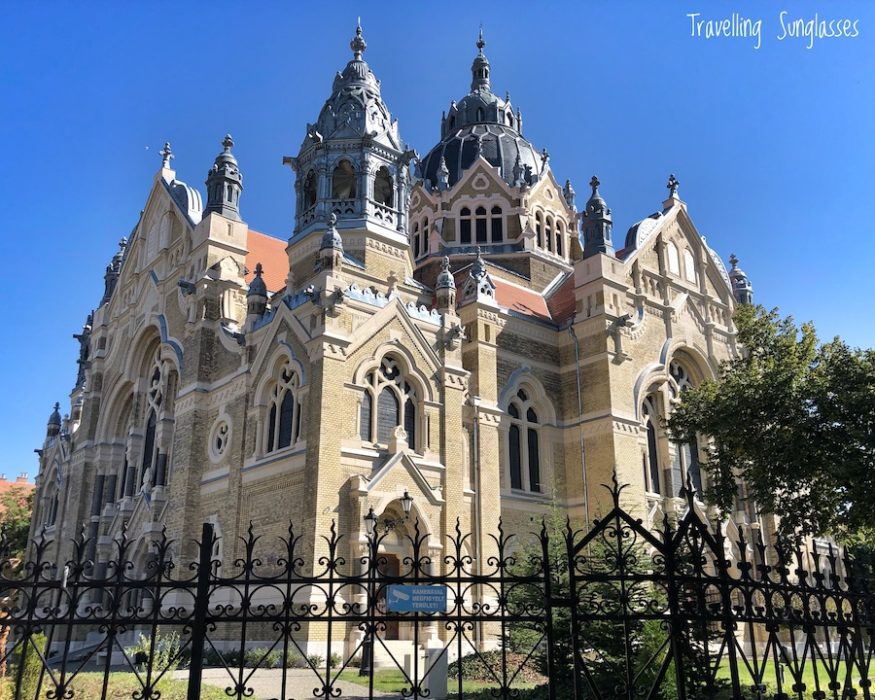
Built in 1903, the New Synagogue (map here) is considered one of the most beautiful Jewish temples in Europe. Multiple architectural styles are featured, from Roman columns to Baroque and Byzantine details. Everything comes together thanks to the tones of white, gold, and blue under the 48-meter tall glass dome: a starry sky as symbol of the infinity of the world, supported by 24 columns, representing the hours of the day.
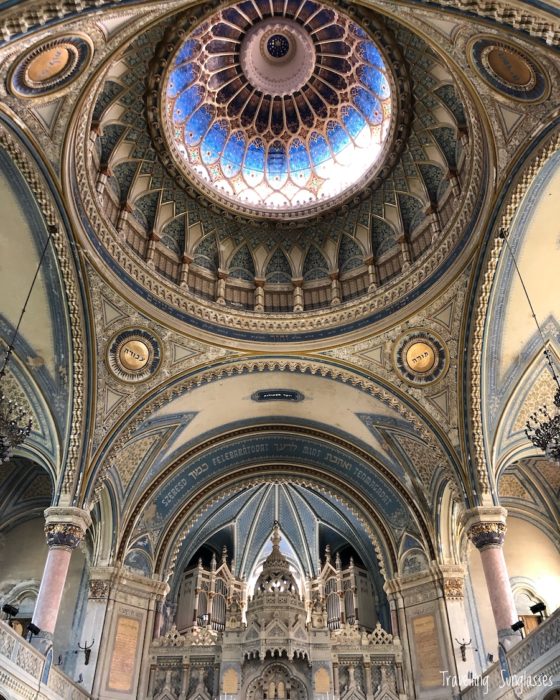
See all the decorations of flowers and animals on the walls and on the stained glass windows? Rabbi Immanuel Lőw listed all flowers, animals and minerals mentioned in ancient Jewish literature. The stunning windows are, again, work of Miksa Roth.
On the vault above the main altar, the commandment “Love your neighbour as yourself” is written in both Hungarian and Hebrew.
Make sure you walk up to the gallery, to admire the decorations from up close.
Visit the New Synagogue
As of September 2019, the ticket was 1000 HUF (approx 2,80 EUR). Closed on Saturdays. Check the updated opening hours on the official website.
Dugonics Square
History and science lesson: by the doors of the University of Szeged (Szegedi Tudomanyegyyetem, map here), say hello to the statue of Albert Szent-Györgyi, the Nobel-prized scientist who identified Vitamin C from Szeged paprika in 1932!
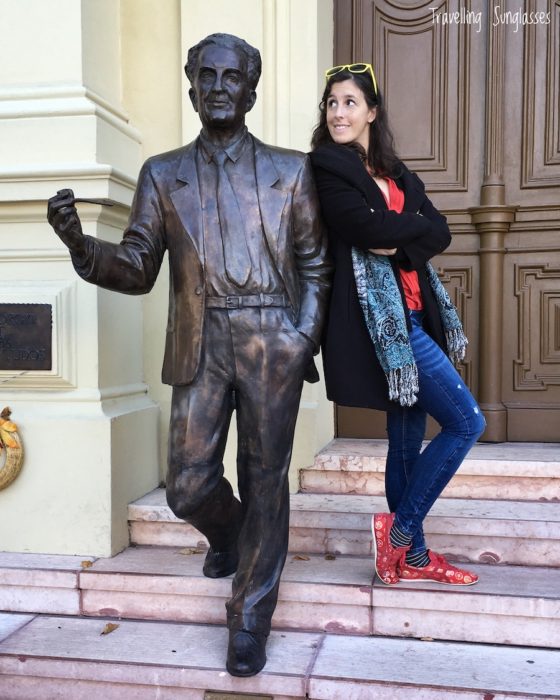
The large fountain in front of it, a popular meeting point, was inaugurated in 1979 on the occasion of the centenary of the Great Flood.
Art Nouveau highlight: Unger-Mayer House
Raise your eyes at the pink building at the corner of Dugonics square and Karasz Street: Unger-Mayer House is a great example of late Art Nouveau (map here). The most impressive attraction is its corner tower with a large dome, where the statues of half-naked ladies holding hands are dancing above the city.
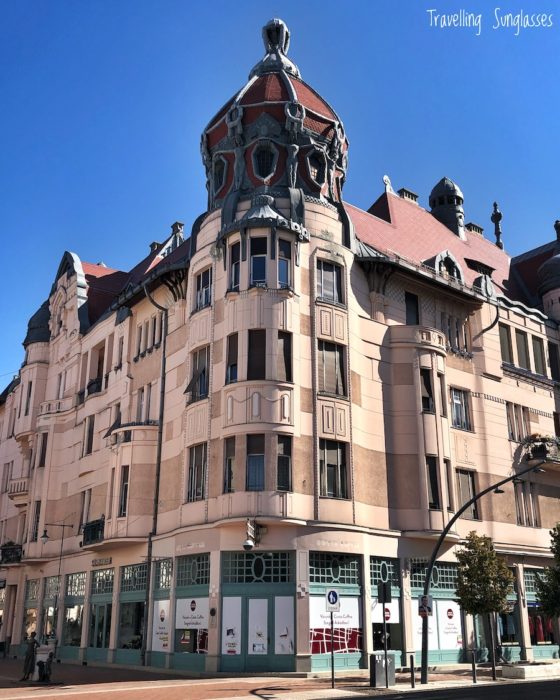
Art Nouveau highlight: Reök Palace
Water is the leading motive of Reök Palace (map here): architect Ede Magyar chose blue water lilies to decorate the columns and walls, whirling water plants for the balcony rails, and shaped the whole building surface in harmonic waves. Nowadays, Reök Palace houses the Regional All-Arts Centre.
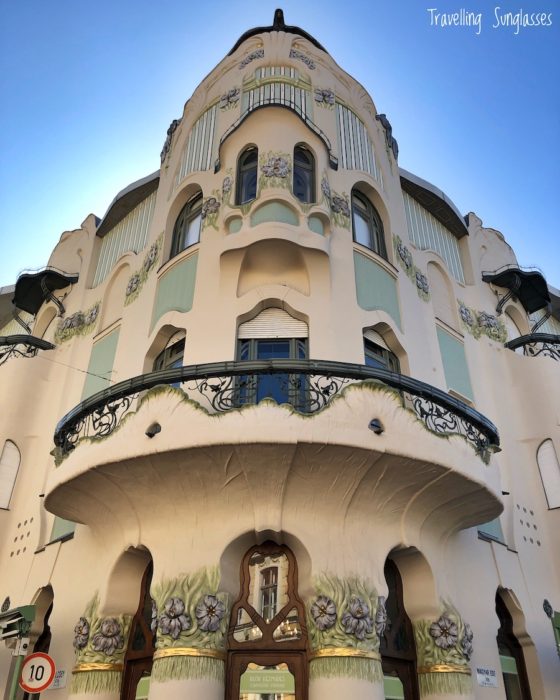
Szechenyi Square
Spacious Szechenyi square (map here), green with majestic trees and embellished with statues of Hungarian historical figures, is surrounded by beautiful, eclectic buildings. The ancient castle walls used to stand here, but they were pulled down after the Great Flood of 1879.
The impressive yellow building opposite the grand fountain is Szeged City Hall, inaugurated by Emperor Franz Joseph in 1883 after some Neo-Baroque modifications that enlarged and improved the previous humble city hall.
Facing the City Hall, to its left, you can catch a very Venetian glimpse: the Bridge of Sights! Unfortunately, it’s not possible to walk through, but it’s lovely to walk under it.

Art Nouveau highlight: Reformist Church Palace
Opposite the Reformist Church on Kalvin Square, the Reformist Church Palace is quite unique and modest at the same time (map here) . Built in 1912 by Ede Magyar for the priests and students of the Protestant School, I was surprised by the unusual “V” shape and by the beautiful mosaics on the top floor of the façade.
Art Nouveau highlight: Gróf Palace
This is definitely my favourite Art Nouveau building in Szeged! A perfect example of Hungarian Art Nouveau.
Gróf Palace (map here) was erected between 1912 and 1913 on a triangular site, which allowed the construction of three façades, two towers, and many balconies. I love the shiny blue and gold mosaics, the wavy contours of the façades and windows, the diverse shapes and sizes of the architectural elements, the folk art and oriental patterns.
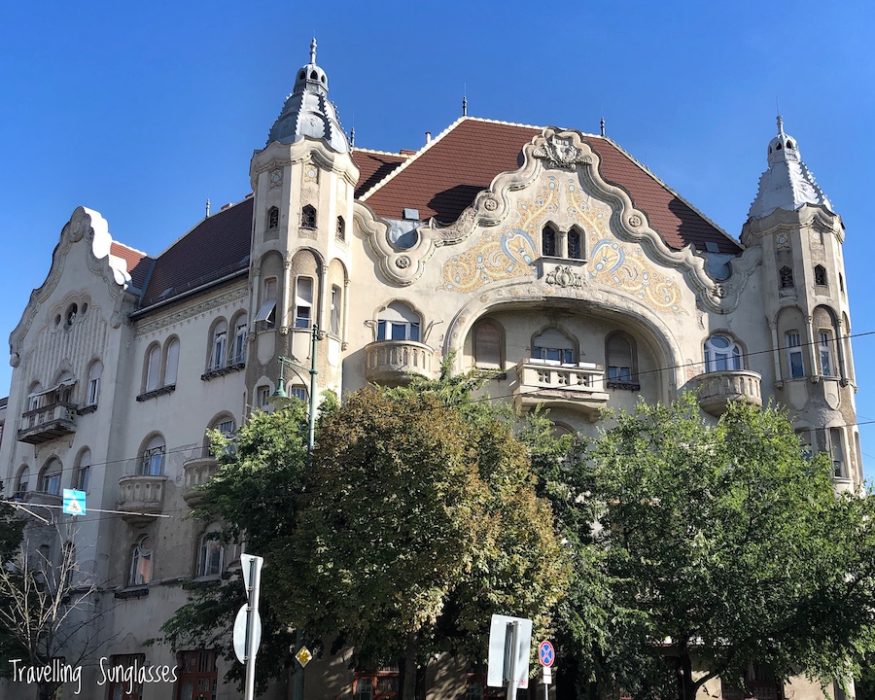
Art Nouveau highlight: Deutsch Palace
More amazing Hungarian Art Nouveau: Deutsch Palace (map here) showcases beautiful elements and patterns from Hungarian folk art, leaves, and flowers, made in the unique Zsolnay ceramics. I love the contrast between the yellow and orange tones of the walls against the green and turquoise of the decorations!
If it reminds you of some palaces in Budapest, it’s because the façade and the staircase were designed by Ödön Lechner: the Museum of Applied Arts and the Postal Saving Bank are also his work.
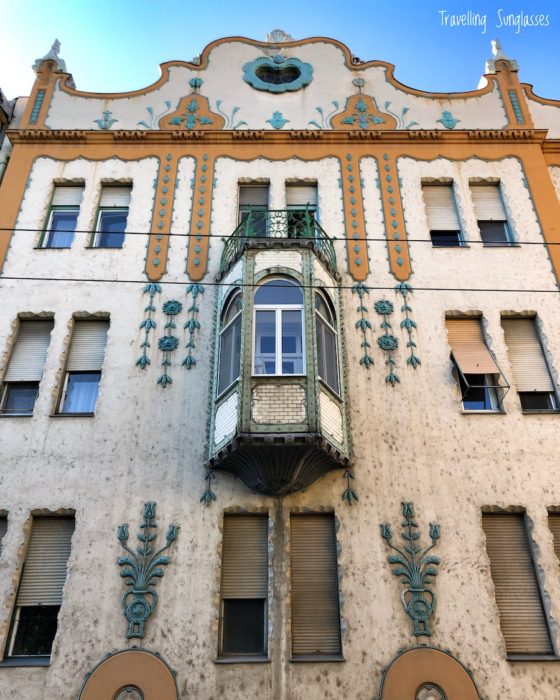
Szeged National Theatre
As grand as a theatre can be: the imposing Szeged National Theatre (map here), which opened in 1883, is a beautiful example of eclectic neo-baroque. Find more baroque frescoes and ornaments also inside.
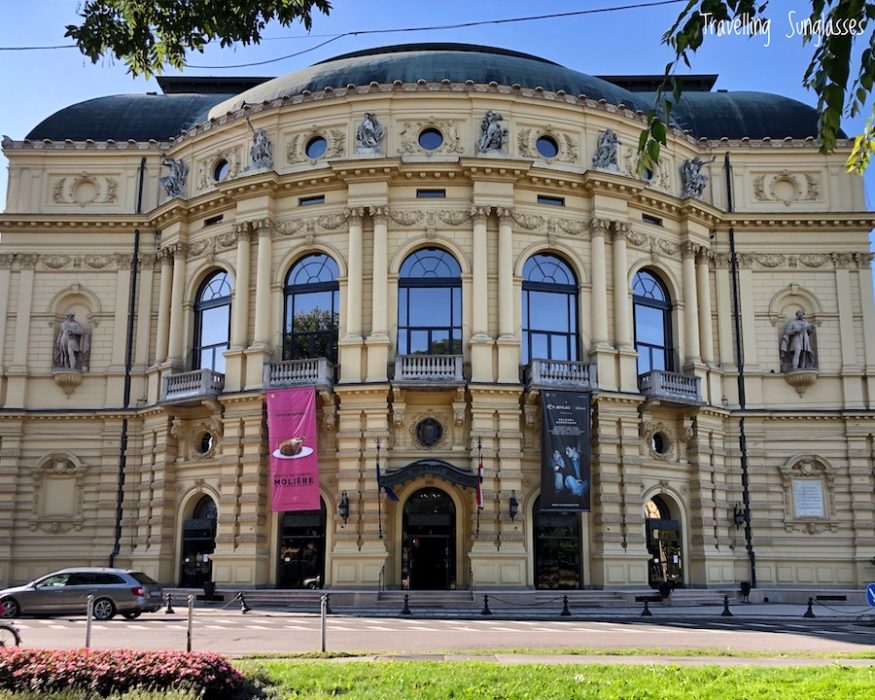
Relax along river Tisza
Take a break at Várkert (map here), the green area by the river Tisza, or walk along the river promenade. The city walls used to run here, before the Great Flood damaged them and they were demolished. There are plenty of beautiful buildings and statues to admire.
Statues and sculptures in Szeged
We were impressed by the amount of statues and sculptures present in the squares and fountains, in the parks and streets of Szeged.
However, I find the most impressive work of art to be the Heroes’ Gate (map here), an archway with a dramatic fresco as a memorial to the Hungarian soldiers who fought and died in World War I.
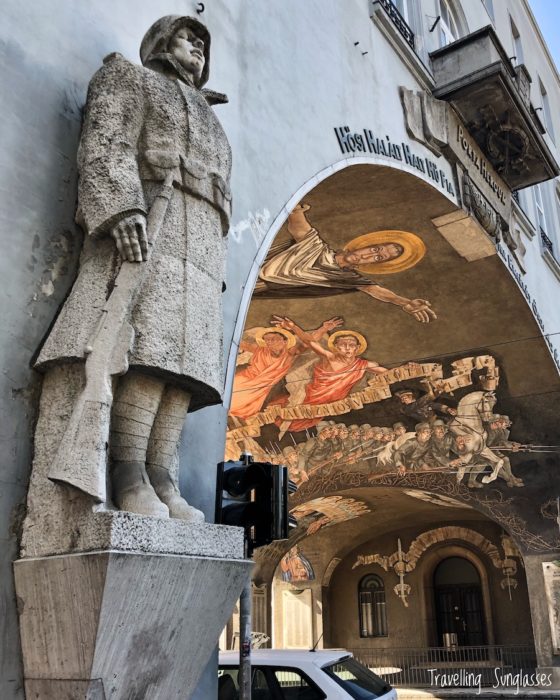
Festivals in Szeged
There are so many festivals and celebrations that take place in Szeged.
We visited during Wine Square Festival in September, and there is also the Szeged Wine Festival in May and the International Beer Festival in July. The Pork and Palinka festival is organized in March, and the Fish Soup festival in September. And of course, there are Christmas markets in December. Check out the updated calendar here.
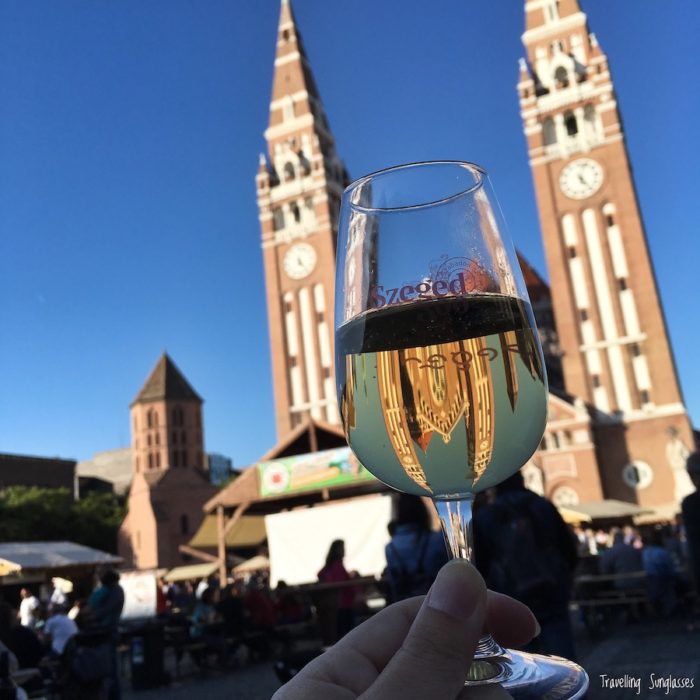
More to see in Szeged
Not enough? Check out also:
- Anna Thermal Baths for some relaxation right in the city centre
- The Serbian Orthodox Church, behind the Votive Church
- Mora Ferenc Museum, in Neo-Classicist style, with exhibitions about Szeged, natural science, and a permanent art collection
- Szeged Zoo
- Sunshine Aquapolis Szeged, with lots of entertaining slides and pools
- Szeged Botanic Garden
- The Contemporary Art Museum at Regionalis Osszmuveszeti Központ
- Pick Salami and Szeged Paprika Museum, located inside the original factory
- The “Viztöröny” Water tower
- Szegedi vár
- Szeged observatory
Hotel in Szeged
We spent one night at Hotel Auris and we were very satisfied. The rooms are new and well kept, decorated in a simple, modern style. Breakfast, a fundamental feature for me, was diverse and tasty. It is conveniently located just outside Szeged old town, on the way to the train station.
Contribute to the local economy: book directly at Hotel Auris here.
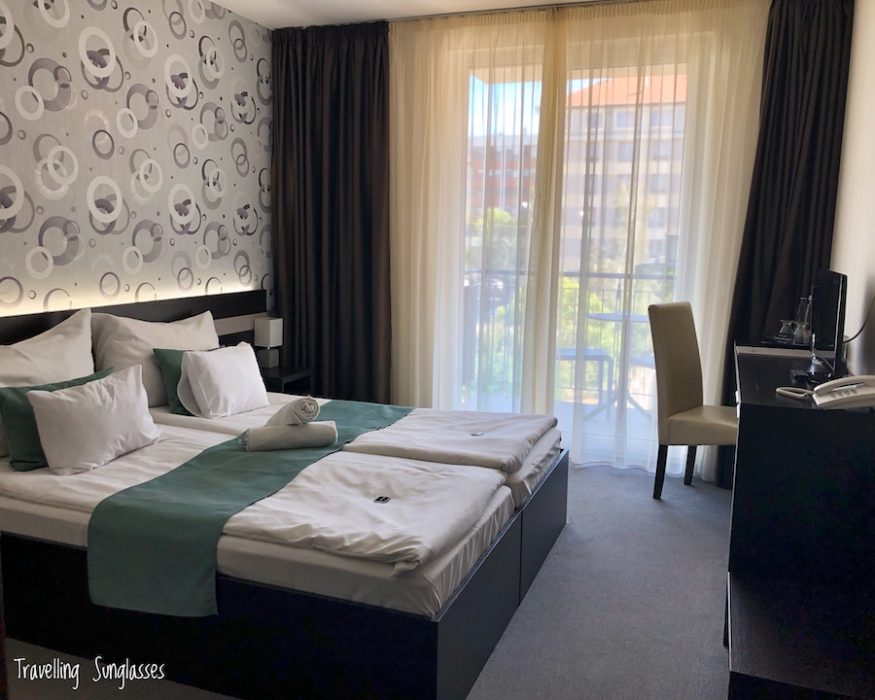
What to eat in Szeged
Szeged is famous for Hungarian paprika and for its fish soup!
We enjoyed a delicious dinner at “Vendéglő a régi hídhoz” (map here): we chose the famous fish soup (in Hungarian: halászlé ) and hearty main courses of meat and vegetables (menu here).
Also, there are plenty of pretty cafes and pastry shops. We tasted excellent cake and cappuccinos at Sugar & Candy (map here).
Conclusion: should you visit Szeged?
Absolutely! Gorgeous architecture, interesting history, beautiful landscapes and outdoor activities, and delicious traditional food: what’s not to like?
We spent two days in Szeged (to be precise, afternoon-night-morning), but it’s also easy to make it a day-trip from Budapest.
Have you been to Szeged? Are you planning to go there? Let us know in the comments 🙂
